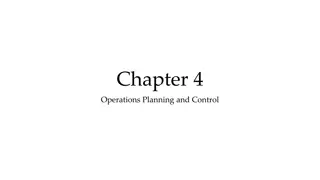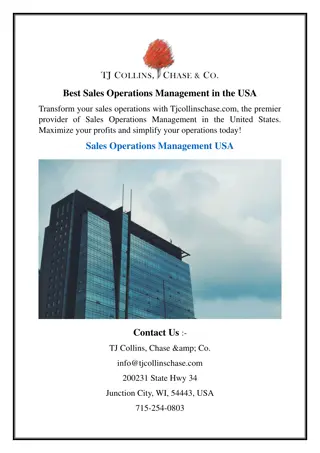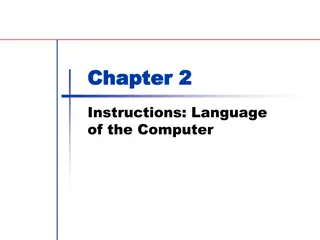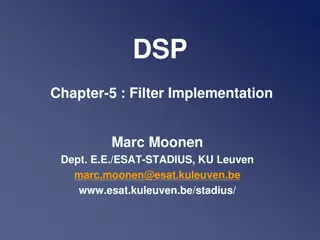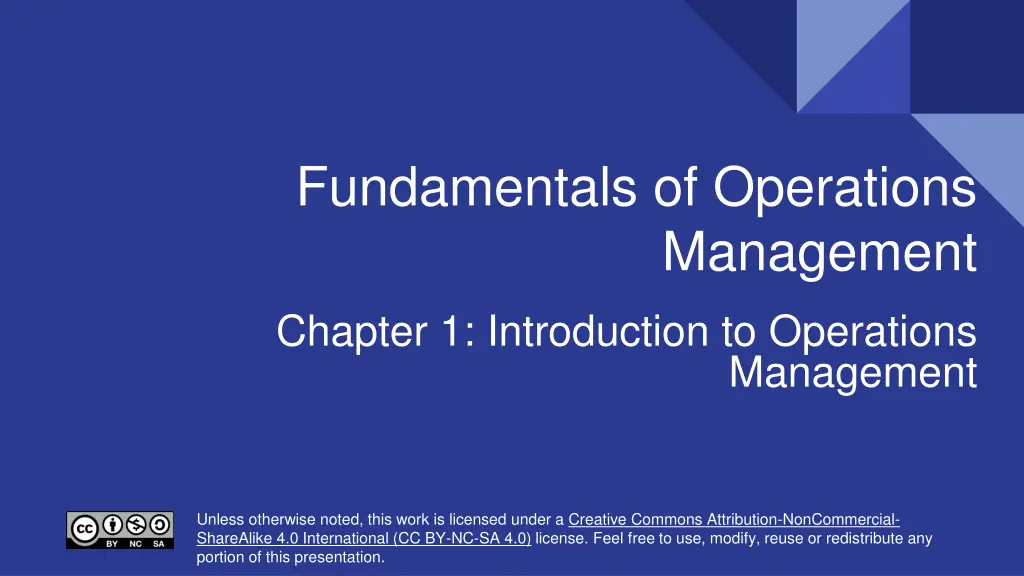
Operations Management Fundamentals Explained
Learn about the essentials of operations management, including key trends, core functions, transformation processes, and the differences between producing goods and performing services. Explore why operations management is vital for businesses and how it adds value to customers. Dive into various categories of transformation processes and understand the role they play in organizations.
Download Presentation

Please find below an Image/Link to download the presentation.
The content on the website is provided AS IS for your information and personal use only. It may not be sold, licensed, or shared on other websites without obtaining consent from the author. If you encounter any issues during the download, it is possible that the publisher has removed the file from their server.
You are allowed to download the files provided on this website for personal or commercial use, subject to the condition that they are used lawfully. All files are the property of their respective owners.
The content on the website is provided AS IS for your information and personal use only. It may not be sold, licensed, or shared on other websites without obtaining consent from the author.
E N D
Presentation Transcript
Fundamentals of Operations Management Chapter 1: Introduction to Operations Management Creative Commons Attribution-NonCommercial-ShareAlike 4.0 International (CC BY-NC-SA 4.0) Creative Commons Attribution-NonCommercial-ShareAlike 4.0 International (CC BY-NC-SA 4.0) Unless otherwise noted, this work is licensed under a Creative Commons Attribution-NonCommercial- ShareAlike 4.0 International (CC BY-NC-SA 4.0) license. Feel free to use, modify, reuse or redistribute any portion of this presentation.
1.0 Learning Objectives In this chapter, we will: Explore the key current trends in Operations Management. Define operations management and its core functions within a business. Explain the role of operations management in transforming inputs (materials, labour) into outputs (goods, services) for a business. Explain why a business student should study Operations Management. Identify some of the Professional Organizations involved in Operations Management. Describe the phases of Operations Management history. Discuss how producing goods is different from performing services.
1.1 Operations Management Operations management is the management of the processes that transform inputs into goods and services that add value for the customer. It is the foundation for any organization, ensuring efficient resource utilization in producing the products we rely on daily. The role of operations management is to design, plan, direct, and improve all the activities involved in producing goods or services. Figure 1.1.1: Operations Management in Everyday Life, London, Ontario by Sanaz Habib CC BY-NC-SA
1.1 Producing Goods and Services In operations management, both the production of goods and the delivery of services play crucial roles. Key Differences Include Nature of Output: Goods are tangible; services are intangible. Services involve more direct contact; manufacturing rarely involves customer visits to the production facility. Customer Interaction: Services require more labor than manufacturing. Labor Content: Services face greater variability due to unique customer needs; manufacturing inputs are more standardized. Input Variability: Manufacturing quality is technically straightforward; service quality is subjective. Quality Measurement: Manufacturing productivity is easier to measure; services are harder to quantify. Productivity Measurement: Manufacturing can store goods; services cannot store capacity. Inventory Handling:
1.2 Transformation Processes A transformation process is any activity or group of activities that takes one or more inputs, transforms and adds value to them, and provides outputs for customers or clients. Organizations often need to transform three types of input: materials, information, and customers. These transformation processes can be grouped into four categories: Manufacture, Service, Supply, and Transport. Service Treatment of customers, storage of products, e.g. hospitals, warehouses Manufacture The physical creation of products, e.g. automobiles Transport The movement of materials/customers, e.g. taxi services Supply Change in ownership of goods, e.g. retail Figure 1.2.1: Categories of transformation processes.
1.2 Transformation Processes (cont.) The overall transformation can be described as the macro-operation. The more detailed transformations within this macro-operation aremicro-operations. Figure 1.2.2: Macro and Micro Operations (transformation processes) by The Open University, CC BY-NC-SA 4.0. Mods: re-coloured by Fanshawe College
1.3 The Operations Function Every organization has a fundamental function related to producing goods and services. This involves resource procurement, conversion into outputs, and distribution to users. The effectiveness of operations significantly impacts customer satisfaction. Operations management is concerned with designing, managing, and improving the systems that create the organization s goods or services.
1.3 Fundamental Functional Areas A typical organization has four fundamental functional areas: operations, marketing and sales, finance, and human resources. Marketing & Sales Human Resources Operations Finance Oversees creation and implementation of product or service Ensures customer s values are met and represented in product or service Hires and trains employees; oversees compensations, benefits, etc. Ensures that funds for materials, supplies, payroll, etc. are always accessible
1.4 Why study Operations Management? More Opportunities Typically, the biggest department, with many job openings Focus on Company over Job Title Focus on finding a great company culture and worry less about the specific job title With a good work ethic, you can likely get promoted to your desired role later. Figure 1.4.1: Operations Management. Microsoft (2024).
1.4 What is Operational Innovation? It s about finding new ways to run the business fulfilling orders, developing products, providing customer service, and more. Businesses want to do the right things (effectiveness) in the best way possible (efficiency). Effectiveness: This means making choices and taking actions that benefit the business and, most importantly, add value for the customer. Think of it as picking the winning strategy. Efficiency: It s about doing things well, but without wasting resources. This means finding ways to streamline tasks and avoid unnecessary steps that cost time or money. Think of it as getting the job done smartly.
1.5 Development of Operations Management Operations have evolved significantly over time, particularly in manufacturing. There are three major phases craft manufacturing, mass production, and the modern period. Craft Manufacturing Mass Production The Modern Period Introduction of flexible specialization, lean production, mass customization, and agile manufacturing Skilled artisans made unique products for individual customers Outputting large quantities of standardized goods at lower costs
1.5 Fourth Industrial Revolution (4IR) The Fourth Industrial Revolution (4IR) builds upon the innovations of the Third Industrial Revolution, also known as the digital revolution. Leverages four key technology categories: Connectivity, Data, and Computational Power, Analytics and Intelligence, Human Machine Interaction, and Advanced Engineering. Figure 1.5.1: Industrial Revolution by Sanaz Habib CC BY-NC-SA
1.6 Key Trends in Operations Management IT is vital in facilitating commerce between businesses (B2B) or between businesses and consumers. Source materials and set up manufacturing in countries with lower costs. Technology Globalization Balance profit with social and environmental gains, emphasizing fair labor, closed-loop supply chains, and life cycle analysis. Increased trade volume facilitated more supply sources and new markets for businesses. Supply Chain Expansion Sustainability Accelerated digital advances, reduced personal connections, and increased scrutiny of social and environmental impacts. Allowed businesses to sell to other businesses or customers online. Recent (Post- Covid) Trends E-Commerce
1.7 Chapter Summary & Review Defines operations management as transforming inputs into valuable outputs (goods and services) and highlights its role in efficient resource utilization. Stresses the importance for business students to understand and improve organizational systems. Covers historical phases from craft manufacturing to mass production and the modern period. Differentiates between tangible, standardized goods and intangible, customer- interactive services. Highlights the interconnectedness of operations with marketing, finance, and human resources for organizational success. Discusses recent trends like globalization, e-commerce, technology, sustainability, and the impact of COVID-19 on business practices.







